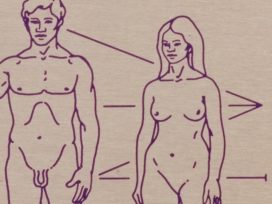It is nowadays generally agreed that we are facing an ecological crisis. Obvious signs of this are the dwindling of natural resources, pollution, climate change and reductions in biodiversity. However, whilst almost everyone is in agreement about the symptoms, the diagnoses vary widely and the treatment to be prescribed varies even more. Is it not the case that “sustainable development”, the remedy that is currently in fashion, actually amounts to no more than a sticking plaster that fails to seek out the causes of the infection? Should this crisis lead not us to rethink the whole idea of development and ask questions about our relationship with the natural world?
In this article I want to put forward a few aspects of the diagnosis that has been formulated by “ecofeminism”. This term, first coined by the French feminist Françoise d’Eaubonne, has had its greatest impact in the English-speaking world, where it has given its name to both a philosophical trend and a militant movement. Far from merely promoting sustainable development, ecofeminists oppose the threefold domination of the white male: over women, over the poor and over the natural world.
It is not my intention here to offer a critical analysis of ecofeminism, which covers a wide range of projects in which it would be impossible to identify a common and consistent philosophical corpus. Indeed, these projects amount to a wide variety of quite distinct approaches, ranging from materialist feminist theory applied to the context of the distribution of environmental wealth, to more spiritual versions based on veneration of a feminine principle in the universe as represented by the goddess Gaia. All I hope to do here is to point out a number of points of convergence between feminism and ecology.
I shall outline this convergence from three angles: epistemological, moral and social. From an epistemological viewpoint, the age-old masculine dominance in the field of scientific research has influenced the way in which bodies of knowledge and methods of investigation have evolved and been given a direction that does not lend itself to an understanding of ecological phenomena. From the moral viewpoint, paternalism and anthropocentrism exert a double domination: that of men over women and that of human beings over the natural world. From the social standpoint, a number of feminists in the South have played a major role in raising awareness of the dangers and injustices that the degradation of the environment has inflicted upon the most disadvantaged peoples. Through their activism, these feminists have brought together women’s liberation and protection of the environment. I shall conclude by pointing out certain limitations in any ecofeminist analysis.
Ecology, feminism and epistemology
Feminist epistemology is a field of research that emerged at the beginning of the 1980s. Several different currents can be found within it and here I shall limit myself to pointing out a few key features of these approaches that can throw light on questions concerning the environment.
Feminist epistemology is based on a critical approach to masculine domination in the field of the sciences, a domination that has for a long time manifested itself in the form of exclusion or discrediting of women scientists. Even though this initial obstacle may be tending to diminish, it still remains in the form of the privileged position enjoyed by a mode of investigation and thinking that feminists would regard as inherently masculine. This is not the place to examine whether there is or is not a feminine mode of thought distinct from the masculine mode and, if there is, whether such a difference is be innate, naturally acquired or socially constructed. One may nevertheless allow that the age-old differentiation in social tasks and roles according to gender coincides with the development and prestige of different cognitive styles.
For feminist epistemologists, masculine rationality is characterized by a mode of thinking that is objective, universalist and reductionist, whereas feminine rationality is said to be subjective, particularist and holistic. Making a distinction of this kind is not tantamount to claiming that all women, and only women, have a homogeneous way of thinking that is different from that of men; it is rather a matter of describing a general tendency that aims to associate certain faculties to one gender or the other. Sex, masculine or feminine, does not determine gender absolutely and, quite often, the personality of an individual is a blend of masculine and feminine traits. For example, boldness or aggression are often associated with the male gender whilst fear or gentleness are supposedly more likely to be found in the female gender. Rationality itself, it is claimed, is not exempt from this kind of sexual assigning of qualities; it is held that there are different types of rationality, some more masculine, some more feminine. The point is not that rationality is claimed to be the distinguishing feature of men, or that they are more naturally endowed with it, thereby contrasting masculine rationality and feminine irrationality. On the contrary, the point is that, whilst both are rational, they may be so in terms of distinct cognitive approaches.
The characteristics ascribed by feminists to masculine rationality represent what often claims to be “good science”. The ideal of objectivity and universality, inherited from modern science, still exerts a powerful influence. One of the corollaries of this view is the strict dichotomy it creates between the observing subject and the observed object. This tendency to objectivize what is being studied, to separate oneself from it, encourages the division that is often made between human beings on the one hand and the rest of the natural world on the other. In fact, ways of thinking that are founded in empathy, a feeling of belonging and of likeness may provide a more appropriate way of understanding ecological phenomena, characterized as they are by the complex interrelationship of human and non-human phenomena.
To the demand for objectivity, feminists oppose standpoint theory. Its central idea is that any knowledge has a location that reflects the particular perspectives of the knowing subject. Amongst the many factors that may colour the way in which a subject may know, gender, it is claimed, is one that is decisive. Because of the long exclusion of women from the field of science, the feminine point of view is alleged to have been neglected. Amongst the many variants of standpoint theory, the more extreme versions maintain that, on many subjects, the feminine viewpoint ought to be privileged. Whilst one may, in part, understand this proposition where it applies to studies that have a direct effect on women, it seems hard to justify in the context with which we are here concerned. Less extreme versions, however, limit themselves to maintaining that having a multiplicity of viewpoints ensures better understanding of the phenomena to be studied. Thus, for example, feminine and feminist perspectives in the field of evolutionary biology have made significant contributions to hypotheses relating to respective male and female mating strategies in animals.
To universalism, feminists oppose particularism. In the context of the environment, the complexity of ecological phenomena, the unique nature of some situations and the interlinking of natural and human causes often mean that attempts to search for and apply general laws or principles proves to be in vain. For example, in the area of biodiversity protection, an approach based on case studies is much more satisfactory than theoretical ecology.
Finally, against reductionism, feminists uphold a holistic perspective, favouring a synthetic way of looking at phenomena in their totality rather than an approach that analyses and breaks them down into distinct parts. Although the point is still disputed, it seems ever more clear that, in ecology, reductionism is a dead end and that, for each of the various levels of organization of life (cells, organisms, populations, communities, ecosystems) there is a corresponding emergent property. The discoveries of Barbara McClintock in the genetics of populations provide a good illustration of the interest of such a holistic viewpoint. In her biography of McClintock, Evelyn Fox Keller describes how McClintock discovered genetic transposition in the mid-1940s by widening her view and looking beyond genes themselves. This way of understanding the phenomenon was at that time inaccessible for most of her colleagues, with their noses stuck in test-tubes, and they greeted her discovery with great scepticism. The importance of her work only began to be recognized ten or so years later and it was in 1983 that McClintock was finally rewarded with the Nobel Prize for Medicine.
So the cognitive approach that is described as “feminine” could offer ways of carrying out investigations and understanding much better suited to ecology and environmental science than the approach considered to be “masculine”. It should, however, be noted that feminists are not the only ones to have put forward an alternative to the universalist paradigm in modern science. Among pragmatists or postmodernists, for example, one can find proposals that tend towards the same conclusions.
Ecology, feminism and morality
A feminist analysis can provide an interesting perspective that makes clear the double domination exerted by men over women and over nature. Carolyn Merchant has described the frequent association made between the concepts of nature and of femininity. Were not the banishment from the Garden of Eden and the Fall the result of a pact between woman and nature (embodied as a serpent), opposing the well-ordered garden with the chaos and savagery of a fallen world? Indeed it is possible to draw up a parallel between views of women and views of nature in the Judeo-Christian tradition. Woman is the opposite, the Other, the non-man, she is miss so-and-so, her father’s daughter, a virgin when the man has not yet penetrated her, the man’s wife once he has made her his woman, his widow once he is dead; in short, she is always described in relation to the man. Similarly, nature is generally viewed in relation to or in opposition to culture. Moreover it is assigned values associated with femininity: it may be virgin or fertile, if it is to bear fruit it must be seeded, it has to be tamed and kept in its place so that it does not threaten the social order. Thus, both femininity and nature are considered as the Other, chaos, the opposite of the order and rationality claimed to be embodied in masculine virtues.
The way that nature is regarded may involve contradictions. It is often thought of as an empty space to be filled, a source of chaos that must be controlled, fallow land to be made fruitful, but untamed nature may also be idealized. The romantic tradition and, even more so, the American preservationists, venerate a kind of nature that is pure and virgin, nature as the only thing that can raise you above that culture that is viewed as mercenary and decadent. Such a view may appear to chime well with ecological considerations, but if one examines it closely, in no case does it make it possible to move towards a reconciliation between human beings and their natural environment. The way in which value is assigned may change but the idea of separation remains. In both kinds of view, nature is seen only in its relationship to man, either because he has to tame it, or because he must exclude himself from it in order to preserve its wild character.
If one extends the analogy between nature and femininity, a similar reversal of values may be noted with regard to femininity in Christian thought. The woman, Eve, through whom misfortune arrives in the world and who bears within her the seeds of vice and corruption, must be made productive and useful, must be transformed into a spouse and mother, made to serve order and reason, that is, recruited to the service of men and of civilization. But there is another, alternative image of woman: that of Mary, the Virgin, pure, sublime, deserving of all honours and veneration. Far from improving the general perception of women, the image of the Virgin crushes all those who are not virgins, reducing all secular women, therefore all real women, to a status that is ordinary and imperfect. In just the same way, focusing all one’s attention on nature that is wild and grandiose leads us to neglect nature that we regard as ordinary, the nature in and with which we live every day.
The ecological crisis ought to lead us to reconsider our relationship with nature in general terms, not only the spectacular kind of nature, but real nature, nature as in our fields, towns, bodies and the animals that we subjugate. Western morality has traditionally considered that human beings may make use of nature as they wished, since its value was purely instrumental and was to be assessed in terms of the kinds of satisfaction that it could provide. That vision of the world, associated with the ideology of limitless technical and material progress, could only ever lead to the systematic overexploitation of the planet that we are witnessing today. Just as a fair society and harmonious social relations are incompatible with the systematic oppression of one group (women or other races) by another, so a reasonably ecological society and a truly fulfilling human life cannot be based on men’s domination and subjugation of the rest of the non-human living world. What ecofeminism asks us to invent are ways of living together based, on the one hand, on cooperation and the absence of domination and subjugation between humans, and between humans and non-humans on the other.
Ecology, feminism and activism
Although feminism and ecology have both developed a theoretical framework, they are above all activist movements, firmly founded in the real world. Their primary objective is to change the way that things work. The links between theory and practice are more or less tenuous depending upon the various groups of activists, but in generally most theoreticians of both camps agree that ideas must serve as premises for or corollaries of action and that they are never sufficient unto themselves.
Ecofeminists in the English-speaking world have very often attempted to see themselves as the voice of all women, and in particular of disadvantaged women, even though this may sometimes have meant that they have lapsed into a naive kind of idealization of native or indigenous women. In doing so, these white, rich western intellectuals were themselves practising a form of domination, perhaps less brutal but more pernicious than the one they were fighting against, by speaking up on behalf other women whilst in no way authorized to do so. But in the ecofeminist constellation, there are a few bright southern stars and I should like to mention two of the most representative figures, Vandana Shiva and Wangari Muta Maathaï.
Vandana Shiva, an Indian physicist, gave up her specialization to devote herself to protection of the environment, to promotion of peasant agriculture and to criticism of the effects of economic and financial globalization. She took part in many struggles on the ground, joining the Chipko group, a movement of women of the Himalayas fighting to protect the forest, and also the Narmado Bachao Andolan Association, which opposed the construction of huge dams on the Narmada river. In 1991, she founded the Navdanya Association, which has set out to protect nature and organic farming, in particular standing up for the farmer’s ownership of the seeds that they sow. Vandana Shiva is both an activist and a theoretician of ecofeminism, and in her numerous books, articles and speeches has stressed the key role played by women in protecting the environment. The central principle in her philosophy is recognition of the Prakriti, the dynamic feminine principle that, to the deadly, homogenizing principle embodied by patriarchal capitalism, opposes vitality, diversity and creativity. She addresses the criticisms of western thought mentioned under our first heading (objectivism, universalism and reductionism), opposing these traditional kinds of knowledge in which there is no real dichotomy between human beings and the natural world, or between men and women, but rather a continuum.
Wangari Muta Maathaï, who received the Nobel Peace Prize in 2004, also stands for a form of militant ecofeminism in the South. She was the founder of the Green Belt Movement, a women’s association that plants trees all over Kenya in order to combat deforestation. She fights a never-ending battle to defend the environment, women and democracy. After several spells in prison and after setting up the Kenyan Green Party, she was eventually appointed Assistant Minister for the Environment, Natural Resources and Wildlife in 2002.
In the case of both Shiva or Maathaï, what we are witnessing is the formation of grassroots movements based on the active participation of members of the community. These are groups and networks of women who together are fighting to preserve a viable environment, to acquire or to maintain their access to vital resources, be it water, wood, land or agricultural products. It is no surprise that it should be women who have sounded the alarm-bells. After all they are the first victims of globalization, since the Structural Adjustments Programmes promoted by the IMF and the World Bank beginning early in the 1980s made the situation of women appallingly precarious in many developing countries. These programmes appropriated most of the male workforce and a large proportion of the available land for cash crops intended for export. In addition to all the domestic tasks that traditionally fell to them, women found that they had to be responsible for production of food crops. Not only was it difficult for them to gain access to the land, but their dependence on men was increased, because it was the men who had an income whilst the women’s work continued to be unpaid. When to this burden were added environmental problems such as access to water or to wood, it became essential for them to organize collectively in order to ensure that their needs and their rights were recognized.
The unsustainability of domination
There is therefore a possible link between feminism and ecology, two movements which, whilst independent of each other are still complementary. However it is important to beware of locking any ecological approaches into an essentialist conception of femininity, as do certain ecofeminists, claiming that women necessarily have a different relationship with the natural world than men. These ecofeminists would claim that there is a privileged connection between nature and women, who, they say, have a fundamentally different way of apprehending the world, living things and society. Naturalist explanations generally support this position. Because they are the source of life, women are said to have a more intimate relationship with living things. Because they raise children, women are supposed to be more ready to understand the long-term effects of their actions. Because they are traditionally responsible for vital functions within the group, it is claimed that they have a more global view of the bonds that link human societies to the natural world. It is easy to imagine the perverse effects of such a rhetorical approach, which criticizes the roles and qualities traditionally attributed to women whilst providing a naturalist justification for their continuation, precisely in those situations where women might well wish to free themselves from such roles.
Nevertheless, if one is careful to avoid any such essentialism and to allow that there is no category labelled “woman” but a multitude of persons, men and women, who wish to maintain with the living world a relationship that is different from the one we have inherited from a paternalist and anthropocentric culture, then the dialogue between feminists and ecologists may be a fertile one. What feminism can teach us, when it applies itself to the question of the environment, is that the present way in which development is taking place, the fruit of the association between reductionist science and paternalist capitalism, is unsustainable. This is not only because the rate at which natural resources are being consumed is greater than their rate of renewal, or even that emissions of CO2 into the atmosphere exceed its capacity for absorbing them. What is truly unsustainable is that the so-called development of our rich societies has only been possible and could only continue at the cost of exploiting and subjugating a large part of the planet, both human and non-human. Refusing to be satisfied with the response that the supporters of “sustainable development” shout from the mountaintops means refusing to allow an iniquitous system to be sustained.
In memory of Marie-Claude Lorne






